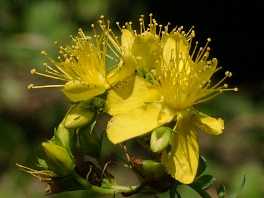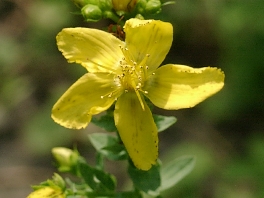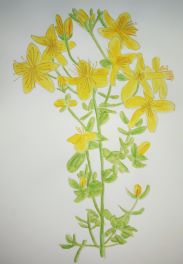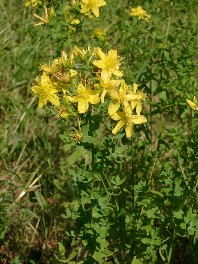 St Johns Wort is the most famous midsummer plant.
Even its name comes from the holy John,
the namegiving saint of the 24th of june.
St Johns Wort is the most famous midsummer plant.
Even its name comes from the holy John,
the namegiving saint of the 24th of june.
In the days around midsummer the St Johns Wort opens its yellow flowers. It stands beside roads, in sunny clearings, at embankments and other sunny places.
The St Johns Wort is associated with the sunlight and warmth of the summer. It absorbes the light of the sun at the longest days of the year, to release it in the dark wintertime when using the St Johns Wort as tea or tincture.
St Johns Wort can bring warming sunlight to depressive minds.
That was already known by Paracelsus in the middle ages.
In our days scientists have found out that St Johns Wort really helps against depression.
Medicinal Uses
- Astringent
- Antibacterial
- Calming
- Stops bleeding
- Inflammation-inhibitory
- Diuretic
- Spasm-dissolvent
- Mucus-dissolvent
- Analgesic
- Strengthening
- Strep throat
- Fever
- Digestive weakness
- Stomach problems
- Gastritises
- Intestinal inflammation
- Diarrhea
- Haemorrhoids
- Gout
- Bedwetting
- Menstrual complaints
- Menopause complaints
- Depressions
- Nervousness
- Sleeplessness
- Epilepsy
- Headaches
- Migraine
- Neuralgias
- Sciatica
- Lumbago
- Effusions of blood
- Contusions
- Bruises
- Aching joints
- Sprains
- Strains
- Varicose veins
- Ulcers
- Wounds
- Burns
- Eczemas
- Dry Skin
Information
| Used Parts: | Flowers, Plant |
| Substances: | Hypericin, Flavonoid, Bitter Essence, Tannic Essence, Tannic acid |
| Time to collect: | June - October |
Methods
 The most famous use of St Johns Wort is its ability to help against depression.
The most famous use of St Johns Wort is its ability to help against depression.
But it is also a strong wound-healing remedy and it has a lot of other abilities.
Depressions
Already in the middle ages St Johns Wort was used against melancholy. Later this use was forgotten, until the medicine rediscovered this effect in the 1970ies.Since then St Johns Wort is the most important herbal against depression.
Other internal uses
St Johns Wort can also help against other problems of the nervous system, sleeplessness and neuralgias.It can strengthen the digestive system and it helps against menstrual and menopausal problems.
Tea
To prepare a tea you can pour one teaspoon full of St Johns Wort with one cup of boiling water.Wait for five to ten minutes and then filter the tea.
Drink the tea in small sips, up to three cups a day.

Tincture
You can also prepare a tincture with St Johns Wort.Use 20-50 drops of this tincture three times a day.
External use
You can use a tea or a diluted tincture of St Johns Wort for washing, bathing and poultices against problems of the skin.The most famous external use of St Johns Wort is the red oil made of the flowers.
To prepare this oil pour a good oil (i.e. olive oil) over St Johns Wort flowers.
Put it at a warm, sunny place and wait six weeks. The oil gets dark red in this time. Filter it then.
You can use the oil for the skin and against sprains and strains.
The oil also helps against neuralgic pains.
View:
|
Beware!
St Johns Wort makes the skin more sensitive against sun light. When using in summertime you may can a strong sun burn. St Johns Wort also disturbes some chemical medicines in their effect. Ask your doctor when using strong medicines, whether St Johns Wort is godd for you. |
Plant description
 St Johns Wort is at home in Europa, Northern Africa and Northern Asia.
St Johns Wort is at home in Europa, Northern Africa and Northern Asia.
It likes dry, sunny places and you can find it beside roads, at the edge of forrests, at stony places and at embankments. St Johns Wort loves ground with a lot of lime.
The perennial plant becomes up to one meter. In the upper area the St Johns Wort is branched out.
Around the stem it has lots of small oval leaves. The leaves have reddish dots, that contain the red oil.
In the midsummer time the St Johns Wort blossoms with lots of yellow flowers. The flowers have five petals.
If you press the petals with the fingers, they become red.
